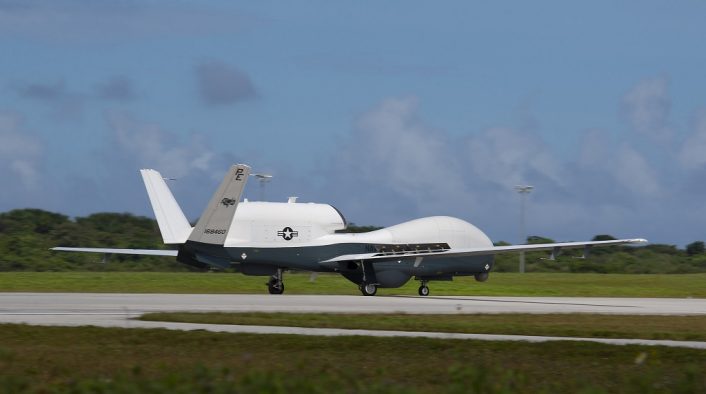The two Broad Area Maritime System aircraft arrived in Guam in January.
The U.S. Navy deployed the MQ-4C Triton Broad Area Maritime System (BAMS) to Andersen Air Force Base, Guam, for the first operational deployment. According to the official photos, the two aircraft arrived at their forward operating base on Jan. 12, 2020, even though the deployment was announced only on January 26.
The Triton is operated by Unmanned Patrol Squadron (VUP) 19, the first Unmanned Aircraft System (UAS) squadron of the US Navy, in an Early Operational Capability (EOC). VUP-19 will develop the concept of operations for Intelligence, Surveillance and Reconnaissance (ISR) missions with the MQ-4C in the 7th Fleet, where it will complement the P-8A Poseidon. The Initial Operational Capability (IOC), planned for 2021, will include four air vehicles with capacity to support 24/7 operations, according to the Navy.
“The introduction of MQ-4C Triton to the Seventh Fleet area of operations expands the reach of the U.S. Navy’s maritime patrol and reconnaissance force in the Western Pacific,” said Capt. Matt Rutherford, commander of Commander, Task Force (CTF) 72. “Coupling the capabilities of the MQ-4C with the proven performance of P-8, P-3 and EP-3 will enable improved maritime domain awareness in support of regional and national security objectives.”
The Triton will bring in the Pacific theater new capabilities with an increased persistence, as wrote in a previous article by our Editor David Cenciotti:
The U.S. Navy’s MQ-4C “Triton” Broad Area Maritime Surveillance (BAMS) is an ISR (Intelligence Surveillance Reconnaissance) platform that will complement the P-8A Poseidon within the Navy’s Maritime Patrol and Reconnaissance Force family of systems: for instance, testing has already proved the MQ-4C’s ability to pass FMV (Full Motion Video) to a Poseidon MPA (Maritime Patrol Aircraft). An advanced version than the first generation Global Hawk Block 10, the drone it is believed to be a sort of Block 20 and Block 30 Global Hawk hybrid, carrying Navy payload including an AN/ZPY-3 multi-function active-sensor (MFAS) radar system, that gives the Triton the ability to cover more than 2.7 million square miles in a single mission that can last as long as 24 hours at a time, at altitudes higher than 10 miles, with an operational range of 8,200 nautical miles.

This first deployment was actually expected to happen in late 2018, after the MQ-4C was officially inducted into service on May 31, 2018. However, in September 2018, VUP-19 had to temporarily stand down its operation following a Class A mishap with the new aircraft. As stated by Cmdr. Dave Hecht, a spokesman for Naval Air Force Atlantic, to USNI News in that occasion, the Triton “had an issue during flight and the decision was made to bring it back to base. While heading in for landing, the engine was shut down but the landing gear did not extend. The aircraft landed on its belly on the runway. No one was hurt and there was no collateral damage.”
The announcement of this first deployment arrived just as Germany canceled its plans to buy four MQ-4C for signals intelligence missions (SIGINT), opting instead for the Bombardier Global 6000, as the Triton would be unable to meet the safety standards needed for flying through European airspace by 2025, as reported by DefenseNews.









